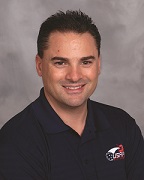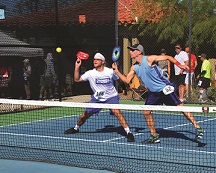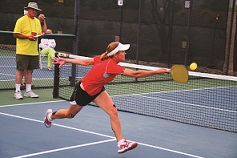
 Pickleball is: One of the fastest-growing recreational sports in the U.S. It is played like a racquet sport: on a court the same size as a badminton court, with a lower net, special regulation pickleball paddles and a ball similar to a whiffle ball. It is played in singles, doubles and mixed doubles. A winning score is 11 and a player needs to win by at least two points.
Pickleball is: One of the fastest-growing recreational sports in the U.S. It is played like a racquet sport: on a court the same size as a badminton court, with a lower net, special regulation pickleball paddles and a ball similar to a whiffle ball. It is played in singles, doubles and mixed doubles. A winning score is 11 and a player needs to win by at least two points.
The USAPA: was organized to promote the growth and development of pickleball, not only on a national but an international level. USAPA provides official rules, tournaments, rankings and promotional materials.
Website: http://www.usapa.org/
Sports Destination Management: Pickleball is growing. We’ve seen articles in the Wall Street Journal and segments on national TV news programs. Are there statistics on participation?
Justin Maloof: Our website has a feature called Places to Play; we track facilities where pickleball is played. In 2013, we recorded 527 new places to play. That is an average of 44 new facilities a month.
SDM: Are those designated pickleball courts?
Maloof: For us, a Place to Play is a place where pickleball games are actively set up. It can be anything from a health club that has designated pickleball courts to a rec center that is now offering pickleball in a gymnasium that is lined for play. We are seeing dedicated facilities with eight, 10 or 12 pickleball courts. In park and rec facilities, we’re seeing conversion of underutilized courts – basketball courts, etc. – being lined for pickleball. The only things we don’t track in Places to Play are school districts, afterschool programs and club and intercollegiate play. We do know those are out there, though.
SDM: In terms of competitive play, what does USAPA offer?
 Maloof: There are sanctioned tournaments nationwide, and we hold a National tournament annually. Last year’s National Tournament was the fifth annual, and was held, as this year’s will be, at the Sun City Festival in Buckeye, Arizona. Last year’s nationals were the largest in the history of the sport; we had 648 people registered, coming from 39 states and five countries. The event ran on 28 courts for a full seven days, and had 1,677 matches. We had singles, doubles, mixed doubles, age bracket play plus an open division. Age divisions went as high as 85-plus.
Maloof: There are sanctioned tournaments nationwide, and we hold a National tournament annually. Last year’s National Tournament was the fifth annual, and was held, as this year’s will be, at the Sun City Festival in Buckeye, Arizona. Last year’s nationals were the largest in the history of the sport; we had 648 people registered, coming from 39 states and five countries. The event ran on 28 courts for a full seven days, and had 1,677 matches. We had singles, doubles, mixed doubles, age bracket play plus an open division. Age divisions went as high as 85-plus.
SDM: Is it hard for people who want to play to find venues?
Maloof: While the sport has exploded in popularity, the construction of venues has yet to catch up. It’s hard to find facilities that are 100 percent pickleball. Last year, two facilities were built in Arizona. One has 24 dedicated pickleball courts, the other has 18. I hear the second facility is going to expand and have either 24 or 30 pickleball courts. Otherwise, there are a lot of multi-use facilities, meaning temporary courts or places that are lined for pickleball as well as other sports.
SDM: How many players are out there?
 Maloof: We don’t actually have a meaningful way to track players; we know how many members we have, but we base our numbers on the people using the Places to Play. We estimate that right now, there are 150,000 and 200,000 people playing, and that number keeps going up. Based on our membership numbers, 69 percent of our members are 60-plus. 25 percent are 40-59 and six percent are 39 and under. Again, if we could factor in the kids using elementary school, high school and college facilities, the number of young people would be higher. It’s funny; I grew up with pickleball and so did everyone in my area. We had it in our P.E. curriculum in school.
Maloof: We don’t actually have a meaningful way to track players; we know how many members we have, but we base our numbers on the people using the Places to Play. We estimate that right now, there are 150,000 and 200,000 people playing, and that number keeps going up. Based on our membership numbers, 69 percent of our members are 60-plus. 25 percent are 40-59 and six percent are 39 and under. Again, if we could factor in the kids using elementary school, high school and college facilities, the number of young people would be higher. It’s funny; I grew up with pickleball and so did everyone in my area. We had it in our P.E. curriculum in school.
SDM: What is USAPA doing to grow the game?
Maloof: We have what we call Ambassadors; they are listed on their website. Their job is to hold clinics and demos and help get people introduced to and interested in the sport. We look for people who really are enthusiastic and interested in pickleball. It’s an easy, fun sport to take up, and we want it to grow.

